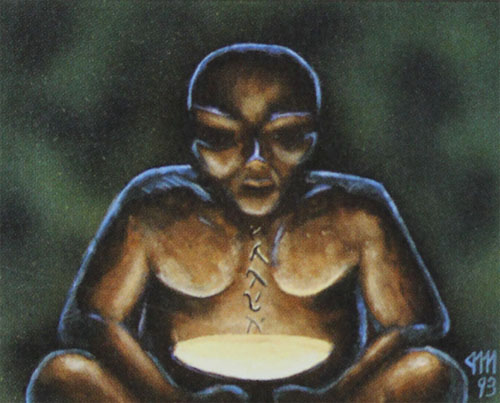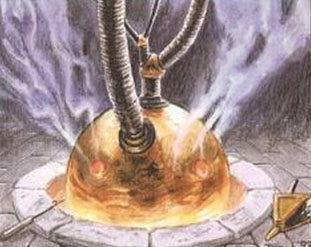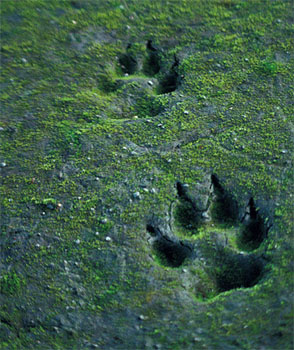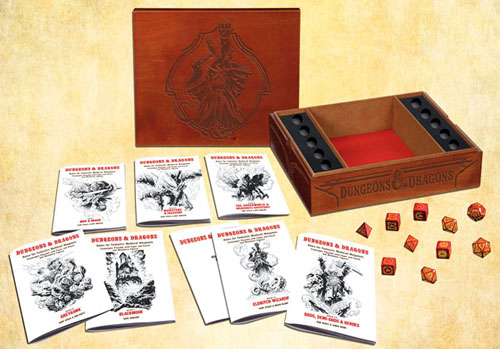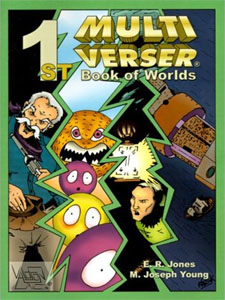 [ The material being reviewed here were provided by the publisher directly to myself with the understanding that I would post a review of the material to RPGNet and the Usenet newsgroup rec.games.frp.misc. The content and conclusions of the review have not been influenced by this arrangement – the opinions contained within are the honest impressions I have of the product.
[ The material being reviewed here were provided by the publisher directly to myself with the understanding that I would post a review of the material to RPGNet and the Usenet newsgroup rec.games.frp.misc. The content and conclusions of the review have not been influenced by this arrangement – the opinions contained within are the honest impressions I have of the product.
The First Book of Worlds is sold in a bundled back with the main Multiverser rulebook for a combined price of $50. I have arrived at an individual price for the two products – which I have reviewed separately – by simply dividing that price in half. As noted in my review of the rulebook I am still encouraging Valdron, Inc. to allow people to buy the products separately. ]
Tagline: Valdron claimed that they had produced a unique game setting. Their critics ridiculed them for it. Their critics were wrong.
I still find it quaint now to think about how much angst and furor was generated by a company pricing their RPG core rulebook at $50. I do recommend checking out my review of Multiverser for the full context of where these reviews came from and the tempest-in-a-teacup which provoked them.
First off, I want to explain where this review is coming from. In, I believe, late 1997 Mark J. Young began posting messages to the rec.games.frp.misc newsgroup about a new game which was going to be coming out: Multiverser. Claims of this being “the new best thing in gaming” and “something unlike anything you’ve ever seen before” were made. The response to these self-laudatory messages was a massive backlash. In my opinion this backlash was never truly deserved, but people had just recovered from similar mailings from the creators of SenZar and The World of Synnibar (two games which did deserve it). Plus, Multiverser was advertised as a $50 product and it wasn’t, initially, well communicated that this was for two books, not one. All in all, people thought they were being hit again by a bunch of clueless morons.
The Multiverser threads dragged on and popped up again and again until, finally, in late 1998, I, and several other people, stepped forward and offered to review the game. Up to that point the people who were attacking Multiverser weren’t about to actually lay down the “outrageous” amount of money required to actually analyze the product they were critiquing – they were quite content to simply attack. You had a situation with very few facts and some very big egos.
To make a long story short I posted my review of the Multiverser rulebook to RPGNet and the newsgroup in late-1998, promising to review The First Book of Worlds separately in the near future. As should now be obvious at the time of this writing (early May of 1999), this did not happen in as timely a fashion as I would have liked. Several other projects came up which gobbled up my time for roleplaying-related activities, I moved, and The First Book of Worlds ended up in a stack of unread roleplaying books a mile high. Plus, I had sort of expended my two-cents on the Multiverser issue in my first review and, honestly, thought that whatever The First Book of Worlds might contain, it probably wasn’t going to add that much to the debate. My review of the Multiverser rulebook concluded that, whatever faults the product might have, it was, in fact, what the Mark J. Young had claimed it was: Something utterly different from what had come before. It was my opinion, sight unseen, that The First Book of Worlds was simply not going to further that basic point at all.
This was my hubris and my mistake.
Indeed, The First Book of Worlds, even moreso than the main rulebook, is something unique. While, obviously, containing familiar elements, it takes those elements and does something fresh and original with them. In the end I was surprised, given all the things about this product I should have hated, that I was left with an overall favorable opinion of it.
WHAT IS THIS PRODUCT?
When first approaching the Multiverser game I was thrown off at first because I was expecting a generic gaming engine and instead got a dimension-hopping game. (This is discussed in my review of the rulebook.) I was thrown off-balance in a similar manner by The First Book of Worlds.
The title, and the premise of the game itself, lead me to believe that the book would be similar in temperament to GURPS Alternate Earths: Several alternate dimensions would be described, based largely on “what ifs” of established history. While there is some of that, The First Book of Worlds defies expectation.
You are are presented with a number of alternate worlds – but many of these are completely alien in their make-up (in ways which will be discussed before). But each world description also serves as the basis for discussing adventuring possibilities. In the same way that old AD&D modules spent as much time detailing location as they did detailing what happened there, each chapter of The First Book of the Worlds describes not just a new dimension, but also a story (or series of stories) which takes place there.
What struck me even more about this, however, was the wide variety of ways in which the stories were presented and told. For example, you had some scenarios which were “tightly” plotted, others which had many different branches, several which were detailed world simulations, and in some cases merely a seemingly exhaustive study of the multitude of ways a specific setting could be used. The authors have demonstrated an amazing aptitude and grasp of a wide variety of storytelling techniques.
THE WORLDS THEMSELVES
NagaWorld. The first world in the book is also the most detailed world provided. The book says, “All verser player characters begin by being carried into NagaWorld.” Those of you who have read my review of the rulebook know that there were several times when the designer made things “requirements” which didn’t really need to be – this is another one of those times. Indeed, the reasons they state for this being the case (NagaWorld was designed to be as alien as possible to leave “no doubt” in the mind of the PCs that they have traveled to another world, among others) are good ones – but why make it an absolute? (This mistake is repeated at other places in the book. In all of these cases the “requirement” is easily ignored.)
Upon arriving in NagaWorld the PCs will wake up lying on their backs in the Orange Plains. These plains are covered in three-inch long “orange grass” which is vaguely reminiscent of astroturf. The world itself is a flat disc. In the center is the “Glass City” – in actuality a massive psionic engine being controlled by the Nash Far Kraal (more on that later). The world is inhabited primarily by the nagas – essentially nerf balls (although the illustrations make them look a lot like the “slimes” which fans of Japanese animation may be familiar with). There are several colors of naga, each with its own unique properties. The nagas are accompanied by a few others interesting, and very unearthly, creatures. The other major inhabitants of NagaWorld are the Dar Koni and the Kreelak – two alien species from another universe waging war against each other.
NagaWorld is actually an artificial construct built in the scriff by the Kraal as an intermediary point for their invasions of other worlds. The Kraal and their technology are all psionically based. The Glass City is the largest of their psionic engines, used to propel them through the scriff and into other worlds. Unfortunately the Glass City is far too huge for any Kraal to operate, so the Kraal created the Nash Far Kraal – a psionic brain which lives beneath the surface of NagaWorld in a sedimentary layer of material which looks vaguely like tapioca.
Now, here comes a Big Design Flaw(TM): You’ve set up interdimensional travelers bent on the subjugation and destruction of everyone else in the multiverse. These are the perfect recurring villains for this type of game – every so often the GM has them pop up to harass the PCs, the PCs get to play freedom fighters until they get killed, and so it goes. Heck, given the way Multiverser works you could even have PCs fighting on different fronts of the same war in different dimensions at the same time. Very Cool.
At this point the guys down at Valdron decide that they should exterminate the interdimensional menace before the PCs ever show up on the scene: The Nash Far Kraal is more than slightly insane and, through a series of events, ends up killing his creators. The author even goes so far as to explicitly deny the GM “permission” to have a Kraal ever show up.
Huh?
Anyway, that would be the first thing I’d change before using this.
The other cool thing about NagaWorld, however, is that the authors have taken advantage of the fact that NagaWorld has appeared in their own decade-long campaign. Because the world is a small place and humans aren’t native it is easy to see the impact they have had. As a result you end up with several elements on NagaWorld left by other versers: It has much the same effect as the lamppost in The Lion, the Witch, and the Wardrobe — a human anachronism in an alien place which creates mystery by begging explanation. The creators have also detailed the pristine version of the world, so that that version can be used if the GM so desires.
The primary focus of NagaWorld is very much one of exploration and survival – as the PCs experiment with the alien ecology to see how they can reconstruct the basic elements of life necessary for survival, while trapped between two warring species in a world ruled over by a psychotic, psionic artificial intelligence.
Tristan’s Labyrinth. “What do you do with a player who just wants to kill monsters? Sometimes you accommodate him. That’s the theory behind Tristan’s Labyrinth, a meaningless morass of corridors and connected spaces populated by unrecognized creatures all having malicious intent.” The authors actually do themselves a disservice in this quote, since they do provide a “meaning” to it – although it’s a little thin (what explanation for a dungeon isn’t?). The labyrinth is an elaborate prison constructed beneath the surface of a nuclear-wasted world. Below the labyrinth, deep within the earth, is the utopian paradise which has been built by the survivors of the nuclear holocaust above.
I initially thought this was going to be a big disappointment on the heels of NagaWorld. Much to my surprise, however, there were a quite a few things to like here. First, the idea of a utopia surviving a nuclear holocaust was interesting. The “dungeon as prison” is an explanation which has been used before, but is a nice touch. Finally, the dungeon map is designed in a rather ingenious non-standard tile formation such that you can create an infinite labyrinth from a simple design which will, if all goes well, keep the players in the dark about the actual layout of the place – even if they conclude that there are repetitious patterns. On top of all this they detail a large number of monsters for the setting, none of which are going to do much more than casually remind you of D&D beasties.
The big design flaw here: Although they tell us that the labyrinth is used as a criminal punishment they expressly say that the PCs will never encounter a prisoner. Again: Huh?
The Dancing Princess. A fairly full world with survivalist adventuring elements and a dungeon crawl with a couple of twists. What’s next? The Dancing Princess is a fairly linear story based on the fairy tale of the same name: The PC answers the challenge of a fantasy king to stop his daughters from escaping from their rooms at night. The PC goes on an interdimensional quest and, in the end, (hopefully) rescues the princesses from demon princes and ends up marrying one of them. This is a very short section of the book, but also includes a brief description of a provincial, traditional fantasy setting of small, isolated kingdoms.
Mary Piper Twin Scenarios. This is an interesting pair of settings. Essentially the PCs appear on the trading ship Mary Piper in mid-voyage. They are, of course, suspected of being stowaways, but eventually join the crew on their adventures. The catch is that there are two Mary Pipers: One plying the waves of a medieval world, another sailing in the void between the stars. The similarity doesn’t end there – crew names and personalities are similar, place names and characteristics are at times identical and at others reminiscent, even the situations and challenges which will be faced by the PCs will be of an eerily parallel nature.
All in all this is a fairly clever idea carried out with a good deal of aplomb and quality. What I would have liked to see, however, was for the primitive Mary Piper to be set in a 20th century setting – one such that the physical appearance of the two ships would be close enough (from the inside) to at least temporarily confuse the PC as to which Mary Piper they were on. Imagine either having the PCs split up, but believing they were on the same ship – or warping the PCs off one Mary Piper and dropping them onto the other, having them believe that they haven’t actually gone anywhere (at least for awhile).
Sherwood Forest. As the name for this world should clearly imply, this is the world of Robin Hood. Once again I prepped myself for disappointment – the rest of the book had always demonstrated either original material or a unique twist on familiar material, but Robin Hood has been done before… many times. What else could you do with him? As you have probably already guessed, the section did not disappoint – largely because of three factors.
First, the authors again demonstrate their care for research, detail, and accuracy through the wealth of historical data presented along with discussions of different historical possibilities. Robin Hood may be a legendary figure, but they highlight that legend with historical fact from the 12th century.
Second, they do not cringe from the possibility of breaking the mold of expectation. One of the two adventures presented in the section (as different “common pursuits” the PCs might go after) deals with the PCs deciding to go after Prince John directly. The authors quickly point out that while the PCs might be able to convince of the Merry Men to follow them, Robin never will – Prince John, after all, is royalty, and you don’t kill royalty. Further, if the PCs are successful, then when King Richard returns they will not be lauded as heroes, but rather condemned and hunted down like the criminals they are. In the other scenario (going off to rescue King Richard), the authors make a couple of interesting historical points – first, if the PCs are already identified as being Merry Men, they will be pursued by Prince John’s forces all the way to the border of his control… which is not the coast as they might expect, but rather the edge of Normandy in France (because at this time in history the Norman royalty of England still had connections to Norman France). Second, that King Richard isn’t going to want to be rescued – it’s against the code of honor he would have subscribed to.
Finally, you actually get two worlds in one. The authors take a great deal of space to consider the possibility that – against all odds – the PCs actually do manage to kill Prince John. They theorize that with his death King Richard will still eventually have his ransom paid and return to England. Richard will still appoint a regent to the throne (a cousin, someone the PCs have never heard of before), and will still turn around and get himself killed in the Crusades. But after this all of English history is changed because Prince John never become King John. They theorize that without the inept bungling of John’s reign, the lords will never rise up and never force anyone to sign the Magna Carta. The Magna Carta, of course, was the document specifying the rights of the king’s subjects – the lords thought they were protecting themselves, but, much to their surprise, they also found that they were protecting their subjects. Whoops. Long story short, the Magna Carta is the direct precursor of the Declaration of Independence and the Bill of Rights – without it all of English society and, consequently, history would be fundamentally altered. Long story short again, the authors present a future setting in which America is still controlled largely by the English throne, which is fighting for control of the territory with France. (They suggest that the PCs warp into this setting shortly after leaving the Sherwood Forest setting.)
Unfortunately, as unique as this setting is, this is also where the Big Design Flaw for this section pops up: The authors theorize that without the emphasis on the individual in the Magna Carta, the Protestant Revolution would never have taken place and the Catholic Church still reigns supreme in the western world. Well, it’s likely that Cromwell never would have had his Revolution, to say that Protestantism would be effected by the Magna Carta is straining credulity – considering it dates to Wycliffe and Martin Luther… neither of whom were English. So, while the Church of England may or may not exist (since Henry VIII would never be king), Protestantism definitely would.
All in all, though, a very interesting section of the book which I enjoyed reading quite a bit.
The Most Dangerous Game. Most of the sections in the book are mostly world with varying amounts of adventure mixed in. This section reverses that trend by having mostly adventure and very little world. Essentially this is a fairly faithful recreation of the short story by Richard Connell. You may have (as the authors point out) read this story in high school English class. Even if you haven’t you have probably seen some adaptation or rip-off of the basic concept: It is widely believed that the short story holds the record for being adapted the most times, either directly or indirectly.
Essentially the plot goes like this: A shipwreck leaves a single man alive, who is pulled to shore and saved by a rich recluse. After nursing the man back to health the recluse informs him that he is the greatest hunter the world has ever known, but he has grown bored with it because he has perfected the sport – no animal is capable of presenting him with a challenge. So (have you guessed it yet?) the recluse now hunts the only prey left capable of challenging him – other humans. Since he saved the man’s life, the recluse claims, it belongs to him. He will give the man a head start of 24 hours and, if the man is still alive at the end of three days, he will be free to go. If I recall correctly, the original story ends when the man turns the tables on the recluse and kills him instead. The version found here is a fairly faithful adaptation (except that the main character verses in rather than being shipwrecked). It is, in my opinion, well done.
The Zygote Experience. This, undoubtedly in my mind, is something that no one else has ever had the guts to try before: An roleplaying scenario about the character being born. I dunno if it really works all that well, but I think the authors deserve kudos for trying something so radically different and unexpected.
Basically there is a tradition among Multiverser players “that once in a great while a character has gone through so much that the referee chooses to start him over as a baby”. The basic rules integrate this into the injury rules in the main book, but I didn’t really give it much thought while glancing over that section before. I mean, sure, yeah, you can have the character reborn, put together a new character sheet, and then start up again “twenty years later”… it never crossed my mind that you would attempt to roleplay through the whole experience.
All in all it’s difficult for me to describe this section in great detail without cheapening it. Let me just say this: First, it is well researched and information is given to you in great wealth. Second, I think it would be a highly playable interlude in a longer Multiverser campaign. Third, it confirms my basic opinion of the overall Multiverser product…
CONCLUSION
…And what is that opinion?
That when Mark J. Young came on the newsgroups and said that Multiverser was something unlike anything we had seen before – and was ridiculed for it – his critics were wrong in saying that it was impossible. Although paper and ink may still have been used in the production of this game, there is no doubt left in my mind now that there are dozens of things which these designers have audaciously attempted (successfully or no) that does does make their product unique, interesting, and inspiring.
On the other hand, there are some problems. First, their writing style can at times be more than annoying – meaningless “mandates” of GM and player behavior; spending too much time telling us how and why they’re telling us something rather than just telling it to us; etc. Second, there are times when their product suffers massive flaws. Third, at times I feel that their very ambition sets them up for failure at a more basic level. Fourth, I think that their complicated, hyper-detailed, world-over-story (sometimes) approach is tragically out of place in an industry which is currently enthralled with simple, broadstroked, story-over-world games. Tragically, I say, because the creators of Multiverser have a lot going for them.
So what’s my final verdict on Multiverser? I have to say that I think the package is worth the $50 they’re asking for it. I think that if you approach these products as something which you need to fiddle with and adjust in order to make it your own, then you will find a wealth of material with which to work. The game may not be for everybody, but I think everybody will find in these massive twin volumes dozens of things which they can use in games of their own.
I also think that if Valdron ever releases the promised Second Book of Worlds (to include Bah Ke’gehn, a world where the demons look like men and the men look like demons; the Prisoner of Zenda; an automated world where the indigs have become primitives in a world which takes care of their every need; western worlds; B-Movie World; the Cask of Amontillado and many more) that I’ll quickly lay out the cash to see what they’ve got brewing.
Style: 3
Substance: 5
Author: E.R. Jones and M. Joseph Young
Company/Publisher: Valdron, Inc.
Cost: $25.00
Page count: 160
ISBN: n/a
Originally Posted: 1999/05/28
In the interests of full disclosure, the Second Book of Worlds was eventually published, but I never laid out my cash to purchase it. Having just converted this review, however, I’ve just added it to my Amazon shopping cart. The First Book of Worlds really is brimming with creativity, cleverness, and a healthy dollop of originality. Even if you skip the Multiverser rulebook, I’d recommend taking the time to check it out.
For an explanation of where these reviews came from and why you can no longer find them at RPGNet, click here.

